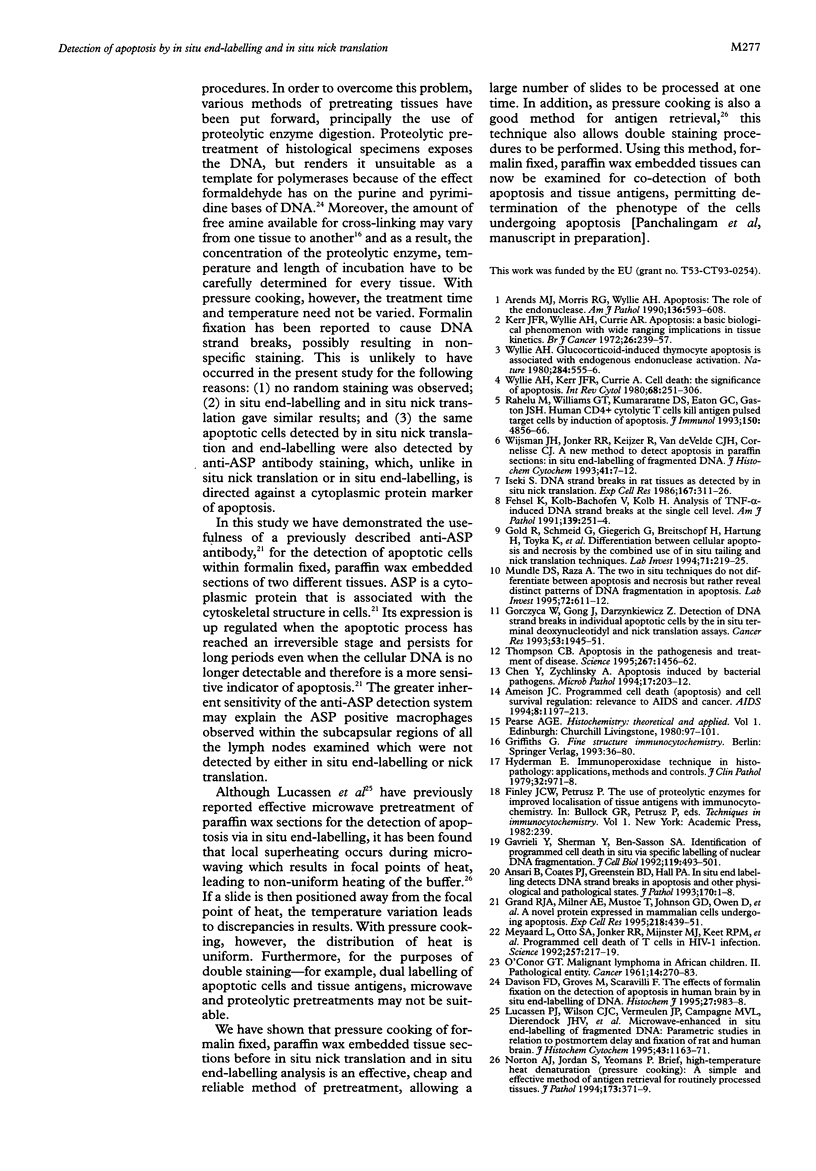Abstract
Aims—To overcome the problems associated with proteolytic pretreatment of tissue sections for the detection of apoptosis.
Methods—Formalin fixed, paraffin wax embedded tissue sections of reactive lymph nodes and biopsy specimens of Burkitt lymphoma were pretreated by pressure cooking for the detection of apoptosis using the in situ end-labelling and in situ nick translation methods.
Results—The results achieved with the in situ end-labelling and nick translations methods were compared with those obtained using a novel anti-apoptosis specific protein (ASP) antibody. The staining patterns generated using the three methods were similar and consistent, although the ASP antibody seemed to be more sensitive and detected higher numbers of apoptotic cells within sections.
Conclusions—Pressure cooking is advocated as an alternative method to proteolytic enzyme digestion for pretreating paraffin wax sections. It is reliable, inexpensive, reduces the need to optimise pretreatment variables for different tissues, and permits double immunostaining of sections.
Keywords: apoptosis
Keywords: in situ end-labelling
Keywords: in situ nick translation
Keywords: apoptosis specific protein antibody
Keywords: pressure cooker
Full text
PDF




Images in this article
Selected References
These references are in PubMed. This may not be the complete list of references from this article.
- Ameisen J. C. Programmed cell death (apoptosis) and cell survival regulation: relevance to AIDS and cancer. AIDS. 1994 Sep;8(9):1197–1213. doi: 10.1097/00002030-199409000-00001. [DOI] [PubMed] [Google Scholar]
- Ansari B., Coates P. J., Greenstein B. D., Hall P. A. In situ end-labelling detects DNA strand breaks in apoptosis and other physiological and pathological states. J Pathol. 1993 May;170(1):1–8. doi: 10.1002/path.1711700102. [DOI] [PubMed] [Google Scholar]
- Arends M. J., Morris R. G., Wyllie A. H. Apoptosis. The role of the endonuclease. Am J Pathol. 1990 Mar;136(3):593–608. [PMC free article] [PubMed] [Google Scholar]
- Chen Y., Zychlinsky A. Apoptosis induced by bacterial pathogens. Microb Pathog. 1994 Oct;17(4):203–212. doi: 10.1006/mpat.1994.1066. [DOI] [PubMed] [Google Scholar]
- Davison F. D., Groves M., Scaravilli F. The effects of formalin fixation on the detection of apoptosis in human brain by in situ end-labelling of DNA. Histochem J. 1995 Dec;27(12):983–988. [PubMed] [Google Scholar]
- Fehsel K., Kolb-Bachofen V., Kolb H. Analysis of TNF alpha-induced DNA strand breaks at the single cell level. Am J Pathol. 1991 Aug;139(2):251–254. [PMC free article] [PubMed] [Google Scholar]
- Gavrieli Y., Sherman Y., Ben-Sasson S. A. Identification of programmed cell death in situ via specific labeling of nuclear DNA fragmentation. J Cell Biol. 1992 Nov;119(3):493–501. doi: 10.1083/jcb.119.3.493. [DOI] [PMC free article] [PubMed] [Google Scholar]
- Gold R., Schmied M., Giegerich G., Breitschopf H., Hartung H. P., Toyka K. V., Lassmann H. Differentiation between cellular apoptosis and necrosis by the combined use of in situ tailing and nick translation techniques. Lab Invest. 1994 Aug;71(2):219–225. [PubMed] [Google Scholar]
- Gorczyca W., Gong J., Darzynkiewicz Z. Detection of DNA strand breaks in individual apoptotic cells by the in situ terminal deoxynucleotidyl transferase and nick translation assays. Cancer Res. 1993 Apr 15;53(8):1945–1951. [PubMed] [Google Scholar]
- Grand R. J., Milner A. E., Mustoe T., Johnson G. D., Owen D., Grant M. L., Gregory C. D. A novel protein expressed in mammalian cells undergoing apoptosis. Exp Cell Res. 1995 Jun;218(2):439–451. doi: 10.1006/excr.1995.1177. [DOI] [PubMed] [Google Scholar]
- Heyderman E. Immunoperoxidase technique in histopathology: applications, methods, and controls. J Clin Pathol. 1979 Oct;32(10):971–978. doi: 10.1136/jcp.32.10.971. [DOI] [PMC free article] [PubMed] [Google Scholar]
- Iseki S. DNA strand breaks in rat tissues as detected by in situ nick translation. Exp Cell Res. 1986 Dec;167(2):311–326. doi: 10.1016/0014-4827(86)90172-2. [DOI] [PubMed] [Google Scholar]
- Kerr J. F., Wyllie A. H., Currie A. R. Apoptosis: a basic biological phenomenon with wide-ranging implications in tissue kinetics. Br J Cancer. 1972 Aug;26(4):239–257. doi: 10.1038/bjc.1972.33. [DOI] [PMC free article] [PubMed] [Google Scholar]
- Lucassen P. J., Chung W. C., Vermeulen J. P., Van Lookeren Campagne M., Van Dierendonck J. H., Swaab D. F. Microwave-enhanced in situ end-labeling of fragmented DNA: parametric studies in relation to postmortem delay and fixation of rat and human brain. J Histochem Cytochem. 1995 Nov;43(11):1163–1171. doi: 10.1177/43.11.7560899. [DOI] [PubMed] [Google Scholar]
- Meyaard L., Otto S. A., Jonker R. R., Mijnster M. J., Keet R. P., Miedema F. Programmed death of T cells in HIV-1 infection. Science. 1992 Jul 10;257(5067):217–219. doi: 10.1126/science.1352911. [DOI] [PubMed] [Google Scholar]
- Mundle S. D., Raza A. The two in situ techniques do not differentiate between apoptosis and necrosis but rather reveal distinct patterns of DNA fragmentation in apoptosis. Lab Invest. 1995 May;72(5):611–613. [PubMed] [Google Scholar]
- Norton A. J., Jordan S., Yeomans P. Brief, high-temperature heat denaturation (pressure cooking): a simple and effective method of antigen retrieval for routinely processed tissues. J Pathol. 1994 Aug;173(4):371–379. doi: 10.1002/path.1711730413. [DOI] [PubMed] [Google Scholar]
- O'CONOR G. T. Malignant lymphoma in African children. II. A pathological entity. Cancer. 1961 Mar-Apr;14:270–283. doi: 10.1002/1097-0142(196103/04)14:2<270::aid-cncr2820140207>3.0.co;2-q. [DOI] [PubMed] [Google Scholar]
- Rahelu M., Williams G. T., Kumararatne D. S., Eaton G. C., Gaston J. S. Human CD4+ cytolytic T cells kill antigen-pulsed target T cells by induction of apoptosis. J Immunol. 1993 Jun 1;150(11):4856–4866. [PubMed] [Google Scholar]
- Thompson C. B. Apoptosis in the pathogenesis and treatment of disease. Science. 1995 Mar 10;267(5203):1456–1462. doi: 10.1126/science.7878464. [DOI] [PubMed] [Google Scholar]
- Wijsman J. H., Jonker R. R., Keijzer R., van de Velde C. J., Cornelisse C. J., van Dierendonck J. H. A new method to detect apoptosis in paraffin sections: in situ end-labeling of fragmented DNA. J Histochem Cytochem. 1993 Jan;41(1):7–12. doi: 10.1177/41.1.7678025. [DOI] [PubMed] [Google Scholar]
- Wyllie A. H. Glucocorticoid-induced thymocyte apoptosis is associated with endogenous endonuclease activation. Nature. 1980 Apr 10;284(5756):555–556. doi: 10.1038/284555a0. [DOI] [PubMed] [Google Scholar]
- Wyllie A. H., Kerr J. F., Currie A. R. Cell death: the significance of apoptosis. Int Rev Cytol. 1980;68:251–306. doi: 10.1016/s0074-7696(08)62312-8. [DOI] [PubMed] [Google Scholar]









